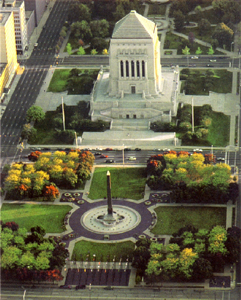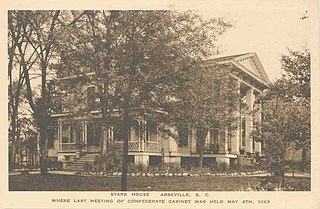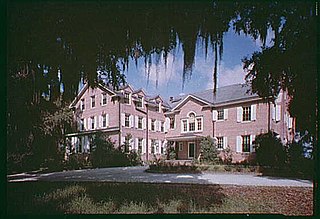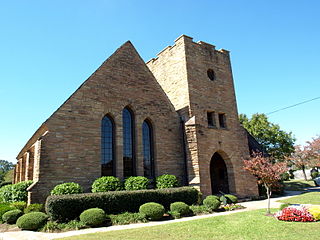
The Wisconsin State Capitol, located in Madison, Wisconsin, houses both chambers of the Wisconsin legislature along with the Wisconsin Supreme Court and the Office of the Governor. Completed in 1917, the building is the fifth to serve as the Wisconsin capitol since the first territorial legislature convened in 1836 and the third building since Wisconsin was granted statehood in 1848. The Wisconsin State Capitol is the tallest building in Madison, a distinction that has been preserved by legislation that prohibits buildings taller than the columns surrounding the dome. The Capitol is located at the southwestern end of the Madison Isthmus. The streets surrounding the building form the Capitol Square, which is home to many restaurants and shops.

The Appomattox Court House National Historical Park is a preserved 19th-century village in Appomattox County, Virginia. The village is famous for the site of the Battle of Appomattox Court House, and contains the house of Wilmer McLean, where the surrender of the Army of Northern Virginia under Robert E. Lee to Union commander Ulysses S. Grant took place on April 9, 1865, effectively ending the American Civil War. The McLean House was the site of the surrender conference, but the village itself is named for the presence nearby of what is now preserved as the Old Appomattox Court House.

The South Carolina State Museum has four floors of permanent and changing exhibits, a digital dome planetarium, 4D interactive theater and an observatory. The State Museum, is located along the banks of the Congaree River in downtown Columbia, South Carolina. It is the largest museum in the state, and is a Smithsonian Affiliate and part of the American Alliance of Museums. Positioned on an old shipping canal that dates back to pre-Civil War times, the museum is widely recognized as a resource for South Carolina history and lifestyle. The museum opened on October 29, 1988 and is housed in what it calls its largest artifact, the former Columbia Mills Building, listed on the National Register of Historic Places in 1982. When the mill opened in 1894, manufacturing cotton duck cloth, it was the first totally electric textile mill in the world. It was also the first major industrial installation for the General Electric corporation. On certain levels of the museum, the original flooring has been kept intact, distinguishable by hundreds of textile brads and rings that became embedded in the floor while it was still being used as a mill. The South Carolina Confederate Relic Room & Military Museum is located within the Columbia Mills Building, and is the oldest museum exhibit in Columbia.

The Alabama State Capitol, listed on the National Register of Historic Places as the First Confederate Capitol, is the state capitol building for Alabama. Located on Capitol Hill, originally Goat Hill, in Montgomery, it was declared a National Historic Landmark on December 19, 1960.

The Stephen Collins Foster Memorial is a performing arts center and museum which houses the Stephen Foster Archives at the University of Pittsburgh in Pittsburgh, Pennsylvania, USA. It is dedicated to the life and works of American songwriter Stephen Foster.

The South Carolina State House is the building housing the government of the U.S. state of South Carolina, which includes the South Carolina General Assembly and the offices of the Governor and Lieutenant Governor of South Carolina. Located in the capital city of Columbia near the corner of Gervais and Assembly Streets, the building also housed the Supreme Court until 1971.

The Indiana World War Memorial Plaza is an urban feature located in Indianapolis, Indiana, United States, originally built to honor the veterans of World War I. The five-city-block plaza was conceived in 1919 as a location for the national headquarters of the American Legion and a memorial to the state's and nation's veterans. At the north end of the plaza is the American Legion Mall, which is the site of the administration buildings of the Legion, as well as a memorial cenotaph. South of that is the Veterans Memorial Plaza with its obelisk.

The Burt-Stark Mansion, also known as Armistead Burt House, in Abbeville, South Carolina was the site of the last Council of War of cabinet members of the Confederate government. On May 2, 1865, Jefferson Davis, hoping to continue the struggle, met unanimous opposition, and realized the Confederate independence cause was lost.

Edward Brickell White, also known as E. B. White, was an architect in the United States. He was known for his Gothic Revival architecture and his use of Roman and Greek designs.

The Robert Mills House, also known as Robert Mills Historic House and Park or the Ainsley Hall House, is a historic house museum at 1616 Blanding Street in Columbia, South Carolina. Built in 1823 to a design by Robert Mills, it was designated a National Historic Landmark in 1973 for its architectural significance. The Historic Columbia Foundation owns and operates the home, which has been furnished with decorative arts of the early 19th century, including American Federal, English Regency, and French Empire pieces.

Magnolia Grove is a historic Greek Revival mansion in Greensboro, Alabama. The house was named for the 15-acre (6.1 ha) grove of Southern magnolias in which it stands. It was added to the National Register of Historic Places on April 11, 1973, due to its architectural and historical significance. It now serves as a historic house museum and is operated by the Alabama Historical Commission.

The World War Memorial in Kimball, West Virginia commemorates African Americans who served in World War I. The building sits on a hill in Kimball, a town in McDowell County, West Virginia. Constructed in 1928, the site was the first memorial of African-American veterans in the United States.

Hobcaw Barony is a 16,000 acres (6,475 ha) tract on a peninsula called Waccamaw Neck between the Winyah Bay and the Atlantic Ocean in Georgetown County, South Carolina. Much of Hobcaw Barony is south of US Highway 17. The land was purchased by the investor, philanthropist, presidential advisor, and South Carolina native Bernard M. Baruch between 1905 and 1907 for a winter hunting retreat. Later, his eldest child, Belle W. Baruch, began purchasing the property from her father beginning in 1936. By 1956, Belle owned Hobcaw Barony entirely. Upon her death in 1964, the property was transferred to the Belle W. Baruch Foundation for a nature and research preserve. The property includes more than 37 historic buildings and structures representative of the eras of both 18th & 19th century rice cultivation and 20th century winter retreats. Hobcaw Barony was named to the National Register of Historic Places on November 2, 1994.

The U.S. Custom House or U.S. Customhouse is the custom house in Charleston, South Carolina. Construction began in 1852, but was interrupted in 1859 due to costs and the possibility of South Carolina's secession from the Union. After the Civil War, construction was restarted in 1870 and completed in 1879. The building was placed on the National Register of Historical Places on October 9, 1974. It is also a contributing property of the Charleston Historic District.

Millwood is the site and ruins of an antebellum plantation house at 6100 Garner's Ferry Road, Columbia, South Carolina. Owned by Colonel Wade Hampton II and his wife Ann Fitzsimmons Hampton, it was the boyhood home of their first son Wade Hampton III and other children. He later became a Confederate general and later, South Carolina governor, and U.S. Senator.

The United States Courthouse, previously known as Institute Hall, Opera Hall, and Memorial Hall, is a building in Natchez, Mississippi that was initially constructed from 1851 to 1853, for use as an educational building. It has served a variety of public purposes in the intervening years. It was listed on the National Register of Historic Places in 1979. In 2007, it was rededicated as a courthouse of the United States District Court for the Southern District of Mississippi.

The Forrest Cemetery Chapel and Comfort Station are historic structures in Gadsden, Alabama. The chapel, comfort station, and cemetery gates were built in 1935 by workers from the Works Progress Administration, and designed by local architect Paul W. Hofferbert, who also designed the Legion Park Bowl. The chapel is designed in Gothic Revival style, with a steeply pitched gable with three lancet arched windows and a square tower with lancet arch opening for the entrance. The front gate columns and wall are connected to a hipped roof comfort building, which originally housed restrooms, but is now used for storage. All three are constructed of rough-cut sandstone blocks quarried from nearby Lookout Mountain. The buildings were listed on the Alabama Register of Landmarks and Heritage in 1988 and the National Register of Historic Places in 1992.

A porch is a room or gallery located in front of an entrance of a building. A porch is placed in front of the facade of a building it commands, and forms a low front. Alternatively, it may be a vestibule, or a projecting building that houses the entrance door of a building.
The South Carolina Confederate Relic Room & Military Museum is located at 301 Gervais Street in downtown Columbia, South Carolina, in a building shared with the South Carolina State Museum. It was founded in 1896, and is the oldest museum in Columbia and the third oldest in the state. "Pressure" from the United Daughters of the Confederacy was a factor in its creation. Historian James Loewen called it "the least accurate museum operated by a state government anywhere in the United States".

The Oklahoma Judicial Center is the headquarters of the Oklahoma Supreme Court, the Oklahoma Court of Criminal Appeals, and the Judiciary of Oklahoma. Situated near the Oklahoma State Capitol, the original structure, designed by the architectural firm Layton, Hicks & Forsyth, was built between 1929-1930 as the home of the Oklahoma Historical Society and was listed on the National Register of Historic Places as the Oklahoma Historical Society Building in 1990. The society moved to the nearby Oklahoma History Center when it opened in 2005. An annex was completed in 2011.























